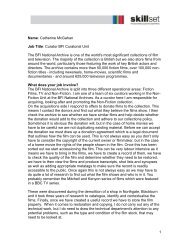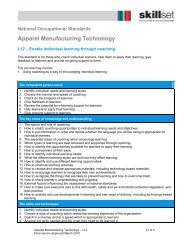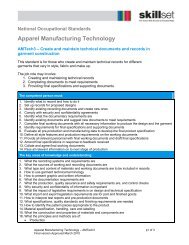Publishing in the Knowledge Economy - DTI Home Page
Publishing in the Knowledge Economy - DTI Home Page
Publishing in the Knowledge Economy - DTI Home Page
You also want an ePaper? Increase the reach of your titles
YUMPU automatically turns print PDFs into web optimized ePapers that Google loves.
<strong>Publish<strong>in</strong>g</strong> <strong>in</strong> <strong>the</strong> knowledge economy<br />
The <strong>in</strong>dustry today<br />
CHAPTER<br />
2<br />
Concepts of competitiveness<br />
2.1 Introduction<br />
This section of <strong>the</strong> report will try to pa<strong>in</strong>t a<br />
picture of <strong>the</strong> <strong>in</strong>dustry as it currently is,<br />
assess<strong>in</strong>g its performance us<strong>in</strong>g a set of<br />
<strong>in</strong>dicators for <strong>the</strong> sector as a whole and its<br />
constituent parts. It will beg<strong>in</strong> by discuss<strong>in</strong>g <strong>the</strong><br />
conceptual and practical issues we encountered<br />
<strong>in</strong> select<strong>in</strong>g <strong>the</strong> <strong>in</strong>dicators and attempt<strong>in</strong>g to<br />
source data to match <strong>the</strong>m. Then, we discuss<br />
and illustrate drivers for <strong>the</strong> publish<strong>in</strong>g <strong>in</strong>dustry,<br />
<strong>in</strong>clud<strong>in</strong>g advertis<strong>in</strong>g trends, consumer spend<strong>in</strong>g<br />
and time use, and demographics. We go on to<br />
exam<strong>in</strong>e some cross-<strong>in</strong>dustry and <strong>in</strong>ternational<br />
comparisons, followed by a discussion of<br />
selected f<strong>in</strong>d<strong>in</strong>gs at <strong>the</strong> level of publish<strong>in</strong>g and<br />
<strong>the</strong>n at sub-sector level. There is <strong>the</strong>n a<br />
discussion of <strong>the</strong> response of <strong>the</strong> publish<strong>in</strong>g<br />
<strong>in</strong>dustry to <strong>the</strong> Internet, which is followed by<br />
a section summaris<strong>in</strong>g <strong>the</strong> areas where data<br />
is unavailable or unreliable.<br />
Follow<strong>in</strong>g <strong>the</strong> quantitative analysis, <strong>the</strong>re is<br />
a section describ<strong>in</strong>g <strong>the</strong> strengths and<br />
weaknesses, opportunities and threats fac<strong>in</strong>g<br />
<strong>the</strong> <strong>in</strong>dustry. This is based on desk research<br />
and on <strong>the</strong> performance <strong>in</strong>dicators, as well as<br />
<strong>the</strong> questionnaire responses, <strong>in</strong>terviews and<br />
focus groups held dur<strong>in</strong>g <strong>the</strong> course of <strong>the</strong><br />
project. F<strong>in</strong>ally, this section discusses scenarios<br />
fac<strong>in</strong>g <strong>the</strong> <strong>in</strong>dustry.<br />
2.2 Sector competitiveness as a concept<br />
Competitiveness is about <strong>the</strong> extent to which<br />
an <strong>in</strong>dividual firm, or national <strong>in</strong>dustry, can<br />
survive and susta<strong>in</strong> itself, and <strong>the</strong> agility with<br />
which it can respond to opportunities and<br />
threats. A firm’s competitive advantage can lie <strong>in</strong><br />
<strong>the</strong> ability to produce at low cost; <strong>in</strong> proprietary<br />
assets; <strong>in</strong> a high rate of <strong>in</strong>novation; <strong>in</strong> produc<strong>in</strong>g<br />
high quality well differentiated products, and so<br />
on. This depends on <strong>the</strong> <strong>in</strong>dustry <strong>in</strong> which it is<br />
engaged, <strong>the</strong> stability of technology, barriers to<br />
entry, <strong>the</strong> rate of entry and exit <strong>in</strong> <strong>the</strong> market<br />
and so forth.<br />
Sectoral competitiveness analysis throws up<br />
some methodology issues. While it is fairly<br />
straightforward to understand what is meant by<br />
<strong>the</strong> competitiveness of an <strong>in</strong>dividual company,<br />
<strong>the</strong> notion of <strong>the</strong> competitiveness of an entire<br />
sector is more problematic. In <strong>the</strong> first place,<br />
<strong>the</strong>re is <strong>the</strong> question of <strong>the</strong> def<strong>in</strong>ition of a sector,<br />
which is rarely clear cut. In <strong>the</strong> second place,<br />
with<strong>in</strong> any sector <strong>the</strong>re will be some companies<br />
that are extremely competitive and o<strong>the</strong>rs that<br />
are fail<strong>in</strong>g. In terms of def<strong>in</strong>ition, sectors are<br />
bound to be blurred at <strong>the</strong> edges. It may well be<br />
that with<strong>in</strong> a broad sector, <strong>the</strong>re are a number<br />
of identifiable sub-sectors, some of which are<br />
grow<strong>in</strong>g and healthy, o<strong>the</strong>rs of which are<br />
decl<strong>in</strong><strong>in</strong>g. Activity may be migrat<strong>in</strong>g away from<br />
some sub-sectors <strong>in</strong>to o<strong>the</strong>rs with<strong>in</strong> <strong>the</strong> sector,<br />
or <strong>in</strong>to an adjacent sector.<br />
The economy is <strong>in</strong> constant flux, and it is<br />
po<strong>in</strong>tless to be too obsessed with def<strong>in</strong>itions.<br />
The competitiveness analysis must aim to<br />
capture this movement and <strong>the</strong> common issues<br />
and problems for <strong>the</strong> sector. Competitiveness is<br />
also a comparative concept by its very nature.<br />
This raises <strong>the</strong> issue what should publish<strong>in</strong>g’s<br />
performance be compared to – o<strong>the</strong>r sectors<br />
of <strong>the</strong> UK economy, <strong>in</strong>ternational<br />
competitors or both?<br />
2.3 The competitiveness of publish<strong>in</strong>g<br />
– conceptual issues<br />
Measur<strong>in</strong>g <strong>the</strong> competitiveness of publish<strong>in</strong>g is<br />
particularly prone to <strong>the</strong> problems outl<strong>in</strong>ed<br />
above, firstly of def<strong>in</strong>ition, secondly of<br />
comparison, and f<strong>in</strong>ally of data availability<br />
(which is related to <strong>the</strong> first two).<br />
2.3.1 Def<strong>in</strong>ition<br />
<strong>Publish<strong>in</strong>g</strong> has historically been l<strong>in</strong>ked with <strong>the</strong><br />
manufactur<strong>in</strong>g process of pr<strong>in</strong>t<strong>in</strong>g. The two<br />
activities have become <strong>in</strong>creas<strong>in</strong>gly decoupled<br />
<strong>in</strong> recent years, even more <strong>in</strong> <strong>the</strong> UK than <strong>in</strong> <strong>the</strong><br />
rest of Europe, but <strong>the</strong> l<strong>in</strong>kage has left a legacy<br />
of <strong>in</strong>tertw<strong>in</strong>ed statistics. Secondly, <strong>the</strong> activities<br />
of publish<strong>in</strong>g companies – especially <strong>the</strong> largest<br />
and most important ones – have <strong>in</strong>creas<strong>in</strong>gly<br />
come to span <strong>the</strong> whole gamut of pr<strong>in</strong>t products,<br />
and have expanded beyond pr<strong>in</strong>t on paper to<br />
electronic publish<strong>in</strong>g, conferences and<br />
exhibitions, tra<strong>in</strong><strong>in</strong>g and audio-visual media. But<br />
this shift is not reflected <strong>in</strong> <strong>the</strong> way that <strong>the</strong><br />
6

















